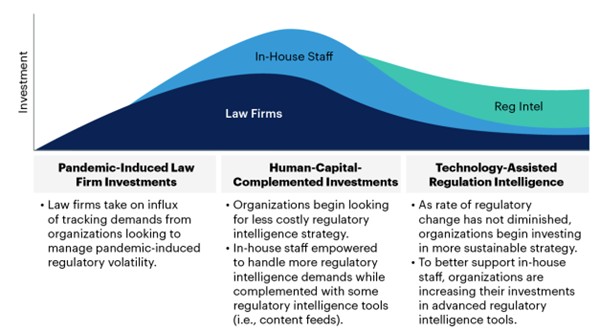Gartner lists four primary options available to legal and compliance leaders to cope with unprecedented levels of regulatory change. These regulatory changes are being driven by increasing regulatory oversight, renewed geopolitical tensions and the ongoing COVID-19 pandemic.
“The blistering pace of regulatory change right now is threatening to overwhelm some legal and compliance teams,” said Nick Sworek, director, advisory in the Gartner Legal, Risk & Compliance practice.
He posits that as the main drivers of regulatory change appear ongoing, legal and compliance leaders will need to find a sustainable way to keep on top of the requirements this will place on their organisations.”
Gartner experts believe three distinct waves of investment in regulatory tracking have emerged in recent years (see Figure 1).
Figure 1: Evolution of Legal and Compliance Regulatory Intelligence Investments

Sworek says at the beginning of the pandemic, legal and compliance leaders turned to law firms for a quick solution to track the regulatory volatility of that time.
“In 2021, when the pace of change clearly wasn’t slowing, legal leaders started looking at less costly in-house tracking options.”
“This year, as legal and compliance teams are finding their ‘new normal’, they are looking at technology investment as a more sustainable strategy to keep up with ongoing regulatory change and support in-house staff,” he continued.
To help legal and compliance leaders understand their options for tracking regulatory change, Gartner experts have identified four main approaches that should be evaluated.
1. Law firms
As illustrated in Figure 1, when faced with regulatory volatility in the early stages of the pandemic, legal and compliance leaders turned to their law firm partners to help stay on top of the changes. This is a good option because law firms tend to have a comprehensive understanding of what regulations apply across geography and industry, and do not require a long onboarding process to get them up to speed.
Sworek cautions that the main drawback of using a law firm for regulatory tracking is that it’s expensive, and that cost is likely to increase further in 2022 as many law firms are set to increase their rates.
“The cost factor has led many legal and compliance firms to look for a more sustainable long-term approach to regulatory tracking,” said Sworek.
2. ALSPs
The second path for regulatory tracking is to engage with alternative legal service providers (ALSPs), nearly a third of which offer some form of regulatory tracking. ALSPs are particularly useful where off-the-shelf products — such as regulatory intelligence tools — cannot meet the organisation’s needs.
“ALSPs are a cheaper option than law firms for regulatory tracking, but they may lack the necessary institutional knowledge to understand which regulatory topics are important to organisations. Additionally, the long onboarding process associated with ALSPs can cause issues, especially when organisations need a quick turnaround to set up a regulatory intelligence program,” said Sworek.
3. In-house staff
In-house staff have deep institutional knowledge and a high degree of business acumen. They understand which regulations are important, and what processes and policies are needed to be changed or created to meet new regulatory requirements.
Using in-house staff also eliminates third-party involvement, creating more control over the process and ensuring flexibility during high-change periods.
“It seems like an ideal solution, except that without a much bigger pool of in-house resources than most legal and compliance functions possess, the scale of the task tends to overburden in-house staff,” said Sworek.
He pointed to a 2021 Gartner study that showed that over half of lawyers were at least moderately exhausted since the pandemic.
“Leaders must evaluate their staff responsibilities to ensure this is a sustainable option,” he reiterated.
4. Regulatory intelligence technology
Some vendor-provided tools automatically track and notify of regulatory changes without human input. Through a variety of capabilities regulatory tracking software aims to automate the regulatory tracking aspect by allowing them to track specific topics and/or regulations, and by sending notifications when something changes (e.g., a regulatory agency adds a new rule to an existing regulation that an organisation is tracking).
According to Sworek these tools are cost-effective for many organisations and offer a long-term solution to staying on top of regulatory volatility, while reducing the burden on in-house staff.
He added that these can also open opportunities to delegate parts of the regulatory intelligence program to business risk owners
“However, such tools still require a human to manage them, and the staff responsible will still face a potentially burgeoning workload as they integrate these tools into their workflows,” he concluded.





